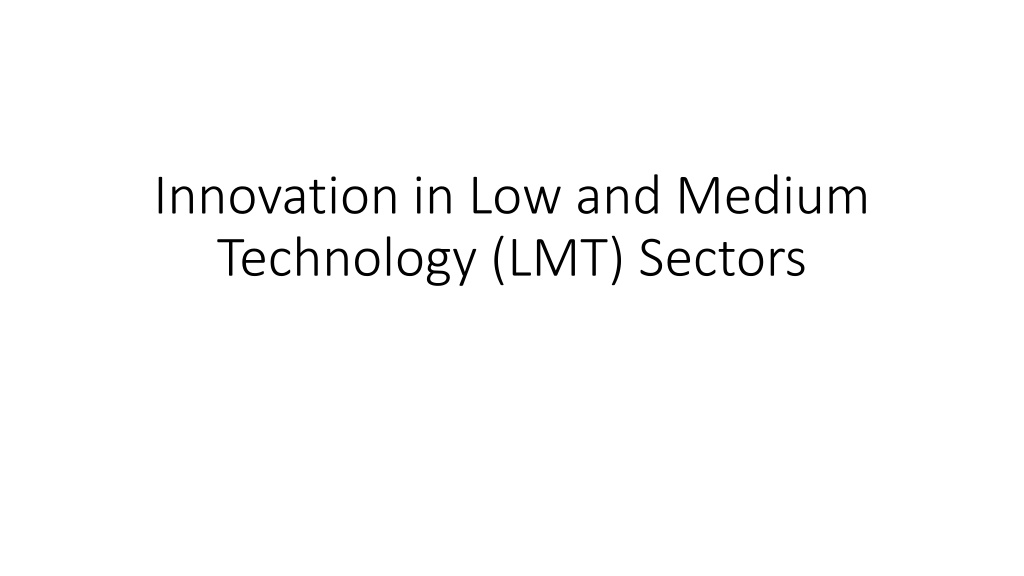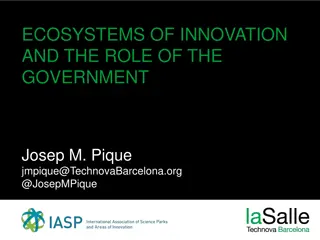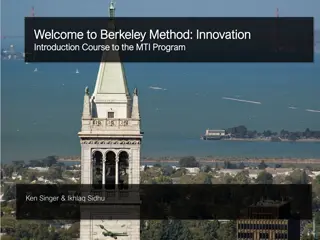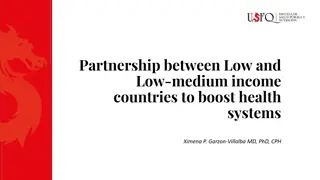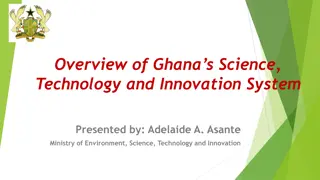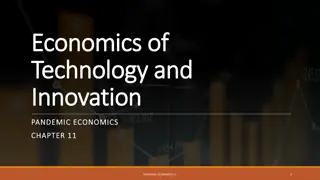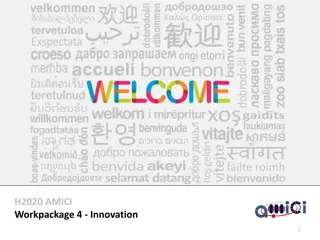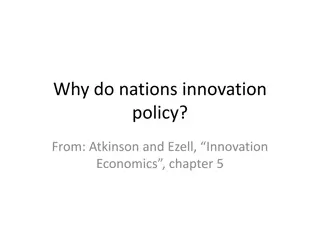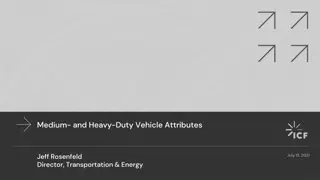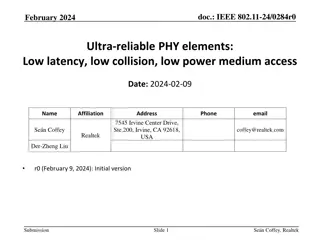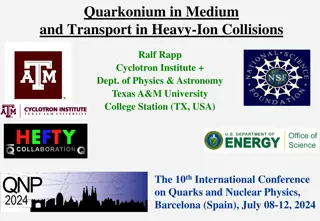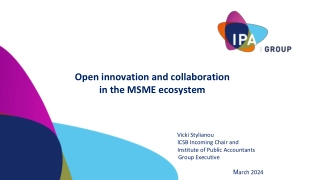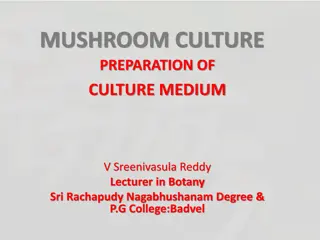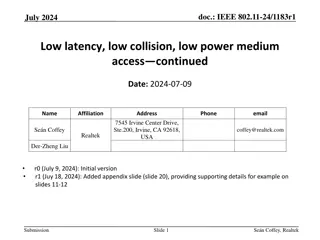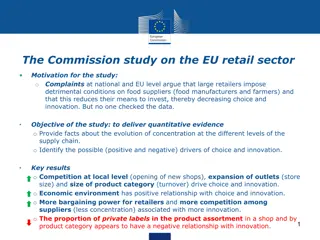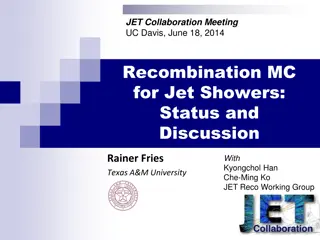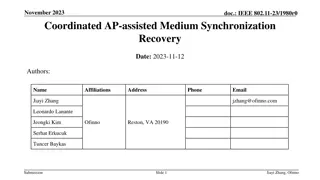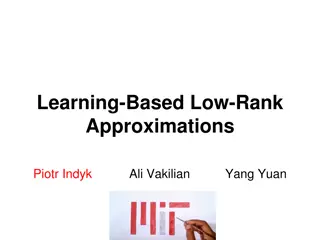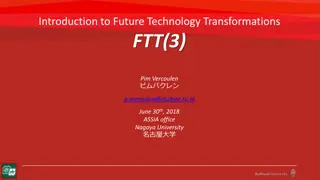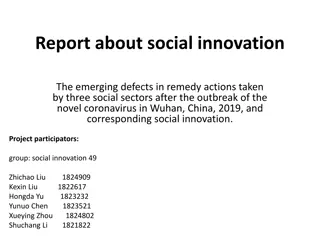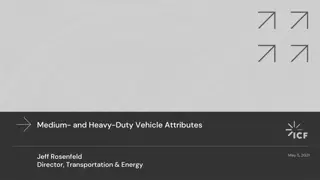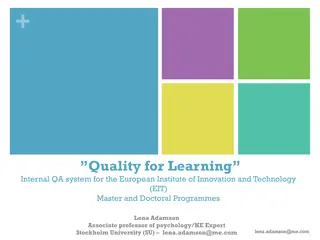Exploring Innovation in Low and Medium Technology Sectors
Understanding the significance of innovation in low and medium technology sectors is crucial for economic development. Traditional classifications like high-tech and low-tech are evolving as innovation blurs sector boundaries. The focus should be on identifying areas with dynamic comparative advantages for sustained growth.
Download Presentation

Please find below an Image/Link to download the presentation.
The content on the website is provided AS IS for your information and personal use only. It may not be sold, licensed, or shared on other websites without obtaining consent from the author. Download presentation by click this link. If you encounter any issues during the download, it is possible that the publisher has removed the file from their server.
E N D
Presentation Transcript
Innovation in Low and Medium Technology (LMT) Sectors
Low-tech industryore than just a matter of semantics It is crucial for understanding where the comparative advantages of countries at varying levels of development may lie. Policy obsession with gaps in high-tech industries has distracted the attention of both policy makers and academics away from making more positive efforts to develop and sustain development in other sectoral direction s which some countries might find more viable. High-tech industries in the OECD account for only about 3 per cent of value- added rising to 8.5 per cent with medium-high-tech industries like car industry Governments need to give more thought to the activities which generate most of the output and employment of their countries and the best targets for dynamic comparative advantage for growth.
Labour and capital The LMT industries are usually regarded as providing many points of entry for developing countries, in view of their relative labor-intensity (e.g. software in India). Some branches of such low-tech industries as food processing are highly capital-intensive (e.g. tobacco and many beverages), as are some branches of building materials (e.g. cement). It also depend on the specific context (es. U.S.A. vs India).
Conventional classification Not just traditional low-tech industries but also those classified by the OECD as medium-tech (= low- and medium-tech , LMT industries.): Mature industries; more slow changes; included non-manufacturing activities (e.g. Oil and Gas); sometimes integrated with services Conventional classifications of sectors as high- or low-tech (etc.), as long practised by the OECD, are becoming less and less useful for academic analysis To be fair, the OECD (2003) came - rightly to place greater emphasis on the knowledge-intensity of industries. Measuring the direct plus indirect technology content of particular industries.
What is a LMT Sector and what innovation in it? Appraising innovation through adopting conventional sectoral classifications can be misleading. Innovation is rapid in particular segments of both high-tech and LMT sectors, (even if more segments of the high-tech sectors display such rapid innovation) It is possible to detach the high-tech segments from LMT industries : e.g. Artificial fibers in textiles when they arose to compete with natural fibers but the final products remain very similar, so this looks specious . .
What are we talking about? Conventionally, sectors of all types were supposed to be different not only in the goods and services but also in the technologies and processes they used to produce them. However The boundaries have blurred over historical time in both dimensions . Technologies originally developed for one set of products spill over into use in the production or architecture of other sets of products. new technologies more often tend to supplement and complement old technologies rather than replace them. even old products can be produced by elements drawn from what had previously been a totally different set of activities (e.g. synthetic fibers in textiles). bundling of goods and services (music on internet)
Innovation drivers in LMT industries 1) The demand The drivers of change as they affect low, medium, and high-tech sectors can be similarly envisaged from the side: 1. of the products (and the demand!) 2. or from the side of the technologies significant differences in interpretation and understanding. Firms hold different interpretative frames , and drivers are particularly important because their well-established markets, necessitate a broader variety of strategic choices for differentiation. Demands change sometimes slowly but sometimes rapidly and unpredictably, negating attempts to routinize operations and generating turbulence.
A) Demand differentiation: 1) quality innovation and 2) new tastes 1) Quality innovation a) New markets Even older industries can bounce back, by producing for new markets. The same type of goods for untouched regions can work for well-known brands (Coca-Cola) but producing different types of the same categories of good ( product differentiation ) is generally necessary for such resurgence. Low-tech industries face somewhat inelastic demands (many produce comparative necessities, and as consumers attain higher income levels, they have satisfed most of their needs for necessities).
b) New scope for new products (also through technolgy) To stave off this satiation of wants, producers in LMT industries have to find new products to attract the custom of higher earners. The availability of advanced technologies may be an important factor for innovation strategies in LMT firms through dictating the scope for such new products. Even then may not result in products that customers find attractive, as has been the case for genetically modified foodstuffs in some countries. In addition to quality upgrading, consumers may switch their demand patterns to goods which have new characteristics. E.g. Auto/food/Energy: intense pressure from communities and from governments to produce safer and more environmentally friendly items. Adding value in processing (e.g. sensors in tires) Shifts in product mixes to reflect the changing composition of consumers, for example the implications of demographic change (gender relations, ageing, etc.).
What defininition to be used? Approaches (= classification; taxonomy, etc.) that blend the technology dimension and the product dimension, appear to be: more analytically satisfying better able to account for observed empirical differences between countries and regions better able to account for dynamic paths of industrial evolution over historical time. They need however to be supplemented by technology-oriented distinctions among sectors (e.g. Pavitt taxonomy) to provide a better grasp of the nature of structural change and competitiveness. Furthermore, they are in our view a more advisable platform for policy than simple OECD-style definitions of high- or low-tech.
Some problems in defining technology! The majority of manufacturing industries are defined mostly according to their product range but a good number have in common their technologies rather than their products, E.g. biotechnology. - plant biotechnology is regarded as part of the biotechnology industry (technology-defined) or of agriculture (product- defined) makes a big difference to the inferences drawn. Moreover innovation activities in LMT tend to fall outside conventional definition of R&D activities (es. OECD Frascati Manual)
Innovation drivers in LMT industries 2) New Technological Paradigms a) General Purpose Technologies and Learning in LMT Firms Key technologies often have the property of being able to become pervasive (they can spill out of their industry of origin and be recruited by older industries) Machinery, steam power, and iron (I Industrial Revolution) information and communication technologies, biotechnology and smart materials in the III IR (= General Purpose Technologies). III created new opportunities for LMT industries to enhance their innovative and economic performance through new technologies However, in LMT industries there is usually little formal learning by science and technology, at least at the firm level (innovation and adoption operate in practical and pragmatic ways by doing and using)
The absorptive capacity and the R&D function The bulk of the general-purpose technologies, are developed by separate companies (rarely subsidiaries), specialized in the relevant technological fields. However the downstream LMT industries need to have absorptive capacities to make productive use of these upstream developments. food-processing companies involved in advanced ( third-generation ) biotechnology do not carry out much of the associated research themselves but are often prominent in patenting in less advanced ( second-generation ) biotechnology this seems to provide them with the necessary absorptive capabilities. Formal science may congregate in national or regional laboratories in such industries, instead of being internalized within firms Innovation require firm-speciWc absorptive capacities, generated not just from formal R&D but from broader-based innovative activities that include engineering, continuous improvement processes, and organizational innovations such as integrated service and supply.
Carrier Industries (general purpose techn.) Describing one particular industry supplying technologies, namely machine tools, Rosenberg (1963) showed how the number of different types of tools was quite limited and as a result their principles could readily be stretched to being applied in industries other than where they were first deployed. Signifcant role of carrier industries, which incorporated these proliferating machine tools into making the machines they produced or used (producing machines related to those tools ). general purpose technologies : any industry can act as a carrier if its demand for the new capital good is large enough or growing fast enough. Thus even low-tech sectors can act as receptors for new process-oriented technologies (e.g. machine tools for 3d printers).
Research in LMT industries. Knowledge search, identification and proof, rather than basic research, are likely to be of particular importance to innovation in the non-manufacturing activities of LMT industries. We have to ask what part of each industry we are characterizing as high- or low-tech when considering their growth potential advantage In low-growth sectors (such as processed foods) innovation lies towards the high-tech end of these low-growth sectors (like applying biotechnology to food processing).
More useful (complex) taxonomies 1) Peneder Peneder (2001): tripartite classification (but starting form Product ) 1. one of his taxonomies rests on factor intensity (mainstream i.e. average; labor-intensive; capital-intensive; marketing-driven; technology-intensive), 2. another on labour skills (low-skill; medium-skill blue-collar; medium-skill white-collar; high-skill), 3. and the third on external service inputs (from knowledge-based services; from retail and advertising services; from transport services; and from other industries).
1b) Peneder Taxonomy Only one of the ninety-nine manufacturing industries Peneder lists ( aircraft and spacecraft ) has the classic high-tech profile of being: technology-intensive and predominantly using high-skill and knowledge-based services! Conversely, there are labor-intensive industries which utilize high skills (e.g. machine tools) and others utilizing knowledge-based service inputs (some branches of metallurgy). His classification underlines the great variety of observable combinations.
2) The Pavit Taxonomy (1984) of sectoral innovation patterns (see also chaptera on SIS) Pavitt (1984) proposes four types of sectoral pattern for innovative activities. I. In supplier-dominated (e.g. textile, services) sectors, new technologies are embodied in new components and equipment, and the diffusion of new technologies and learning takes place through learning-by-doing and by-using. II. In scale-intensive sectors (e.g. autos, steel), process innovation is relevant and the sources of innovation are both internal (R&D and learning-by-doing) and external (equipment producers), while appropriability is obtained through secrecy and patents. III. In specialized suppliers (e.g. equipment producers), innovation is focused on performance improvement, reliability, and customization, with the sources of innovation being both internal (tacit knowledge and experience of skilled technicians) and external (user producer interaction); appropriability comes mainly from the localized and interactive nature of knowledge. IV. Finally, science-based sectors (e.g. pharmaceuticals, electronics) are characterized by a high rate of product and process innovations, by internal R&D, and by scientifc research done at universities and public research laboratories; science is a source of innovation, and appropriability means are of various types, ranging from patents, to lead-times and learning curves,
Difficulties in classifying LMT! Pavitt (and others, as Marsili) deliberately aimed at means of classification that brought together characteristics which certain groups of technologies appeared to share, even though they might pertain to different sectors. Generally this taxonomies do a better job of explaining technological performance than factor content ..However, again, the LMT industries resist easy classification, precisely because many of them are not very distinctive or singular in technological terms. For instance: growing export industries sprinkled all first four categories of Pavitt taxonomy!
3) The Sutton taxonomy: relationships with the industry/market structure Sutton: firms are prepared to spend on marketing their products on the one hand, and on developing their technologies on the other (trad-off) It depends on factors that were partly under a firm s control and partly beyond it! Sutton approach and associated taxonomy can be especially useful for analyzing LMT industries, because supply (technology) is combined with demand (product) aspects in a rigorous way.
E.g. The tire industry E.g. Tire industry - Sunk costs; heavy market concentration; Capital intensive; large scale; not strong changes in basic technology (rubber) Global Oligopolistic structure! Technology is applied by the tire manufacturers to reduce costs, to differentiate the product line and to focus on greater value-adding activities (Acha and Brusoni 2003). Complexity in the nature of Knowledge Basis; Interface between chemical knowledge base (rubber) and others (sensors, electronics, car engineering, etc.) Facing a global market where it is more and more difficult to make a profit, the leading manufacturers are continuously focusing on reducing costs through reducing throughput and labor costs (including the long-awaited introduction of robotics), innovations in processing technologies and source product (a new polyurethane tire polymer), and in the method itself (e.g. sensors in tires). Beyond influencing the cost and ease of production, tire manufacturers have invested in research and technology to also help them to move away from the commodity trap, where products can only compete on price. (e.g. also marketing: colored tires!). Or moving up the value chain by manufacturing entire tire assembly systems. High-tech providers; Patents; High R&D rates
Fi r m s a n d Co r p o r a t e Fi r m s a n d Co r p o r a t e Ch i i n L M T In d u s t r n L M T In d u s t r i i e s = Issues concerning strategies and structures at the firm level (economies of scale and scope; vert./horiz. Integration) in both large firms and SMEs: relations with technologies and innovation processes Ch a n g e a n g e e s STRATEGIES A) orthodox vision Porter (1985) : three main types of corporate strategy, namely: a) cost leadership, b) differentiation; c) focus. cost leadership is the likely choice of firms in a mature LMT industry (process innovation only to pare down costs even) . B) Alternative points of view: technology related also to . Branding (product reputation) is often crucial to the choice of a differentiation strategy (e.g. Skoda is nowadays using advertising of its new technologies to change deep-seated customer prejudices); Focus in terms of multidivisional firm (many focused markets): it may rise several problems (if there are spillovers between the same functions located in different divisions)
Why Porter approach is not valid in interpreeting the technology issue in LMT industries? In contrast to the orthodox vision (Porter), in practice, managers consider particular activities rather than the whole ( corporate strategy ) at once. A technology frame (and not a pure strategic frame), therefore, is the actual interpretative system of managers to understand the firm technological position and innovation opportunities! Oil and Gas industry: there is little direct correlation between formal technological performance (say patenting and scientific publications) and business performance (say expansion or profitability), unless this intervening variable of the frame is accounted for by managers!
The technology frame concept The frame concept is relevant to the study of innovation in LMTsectors. Firms in LMT industries are basically using rather than selling technology, and therefore tend to adopt technology frames that are: a) quite different from those in high-tech industries (where technology itself is a key selling point), b) and often quite different from other LMT firms even in the same industry. In general, the market characteristics of LMT industries (segmentation, differentiation, etc.) lead firms to different interpretations about the role for technology for commercial success. In high-tech firms, by contrast, the role for technology is more central to commercial success, and there may be greater tendencies for consensus (general or by groups) on aspects of technology frames across these competing firms variation in technology frames across high-tech firms derives more from a focus on how the technology (broadly stated) should develop, whereas variation in technology frames amongst LMT firms pertains more to what the role for technology (broadly stated) should be.
Scale and Scope in LMT industries and technology: Large Firms and SMEs Some mature LMT industries (as meatpacking, automobile production, and consumer durables, etc.) were important sources of production innovation in their early years It is (partially) true that driving force of mass production was to reap economies of scale in the production processes, and the M-form (multidivisional) company was a very suitable organizational form for doing so However, time-saving was a very relevant way to get economies: this was achieved through raising throughput, reducing downtime, and improving the machinery Dynamic economies of scale, not usual static scale economies arising, for instance, out of having large plant!
New ways to get dynamic economies of scale LARGE COMPANIES decline in average establishment size ( minimills ) system of lean production (e.g. Toyota) - which was a response to the needs of customers for variety and specialization while sacrificing as little as possible of the benefits of high throughput; Just in time, etc. dynamic economies of scope to balance loss of standardization; Long run conversion process, but innovation and technology often related to those targets!
SMEs innovation potential (in LMT industries) Small and medium-sized enterprises (SMEs) have reappeared on government technology policy agendas. Renewed emphasis as possible sources of innovation (perceived advantage of SMEs in responding quickly to technological change, because of the absence of complex management structures within smaller enterprises). Against that, SMEs may lack the financial power to undertake the kinds of investments in new technologies Questions of access to new technologies and on what terms; they are often (perhaps unfairly) seen as a matter for despair in LMT sectors.;
Vertical and horizontal integration The LMT industries have been characterized by a variety of patterns of vertical integration and disintegration through their development across time. 1. At the beginning, high degree of vertical stratification (not integration) - segments interact in systemic fashion with one another through the vertical chains. imbalances in development affecting the value chain . 2. In the second phase of industrialization there were pressures to link the segmented processes (vertical integration. The pressures of throughput that gave rise to mass production ; smooth production flows throughout the value chain). 3. More recently, the rise of the steel minimill , partly from technical change, at the expense of the large integrated mill has been one of the more dramatic demonstrations of a retreat from vertical integration (see before).
Recent trends at firm level Tasks previously undertook have been outsourced , thereby returning to the traditional low-tech model of vertical disintegration even in some high-tech industries. To retain and intensify the economies of scope required in this unfolding set of circumstances, companies also chose to limit the range of their horizontal diversification. downsizing and in many cases stripped out large numbers of middle management in the belief that this furthered lean production. While financial considerations had often encouraged diversification into unrelated activities, studies demonstrated that conglomerate firms based on unrelated diversification were not very profitable.. Taking on board the technological and production aspects, and thereby taking into account the issues of synergies and economies of scope, many firms reoriented their structure to limit themselves to related diversification. Yet many of the larger companies in low-tech industries like food manufacturing continue to pursue apparently unrelated diversification: low technological opportunity in traditional segments of low-tech industries may also go with relatively high appropriability, especially through branding (rather than through technology!)
Dynamic changes at industry level: Vertical Alignment and Networks Changes at the firm level in terms of size, integration and diversification carry strong implications for the structure of the industries. To overcome hierarchical control, firms have been driven to develop closer relationships with upstream suppliers and downstream customers. Toyota system: high reliance on suppliers to deliver on time and of high quality; joint development with the supplier; long periods of time negotiating the exact specifications and costings; first-tier (or second tier, etc.) suppliers worked in close association with Toyota wherever the production was located, as Systems integrators hat is, Each integrator would be surrounded by a network of suppliers and related activities. New power balance emerge; In the lower-tech industries especially, like textiles and some branches of food, the manufacturing stages of the chain were squeezed as power tended to shift downstream to the final stages and even to the retailers.
Industrial patterns How do industries differ in their behavior?; Can one observe different patterns in LMT industries than high-tech industries at the industry and sector levels? Are the Schumpeter Marks relevant and useful? What results if you adopt the SIS approach (Malerba)? key conditions: opportunity, appropriability, cumulativeness, and knowledge base). Clothing falls o into the category of Mark I, characterized by low technological opportunity, weak appropriability of any innovations, small firms and rapid entry and exit, practical rather than scientific knowledge base. Motor vehicles as a medium-tech industry have greater technological opportunities, greater appropriability and the persistence (cumulativness) of large firms.
Technological opportunities and outsourcing Some of the lowtech industries are Mark I but others are nearer to Mark II, while food-processing resists any easy classification since its sub-branches operate in a whole variety of ways. Where demand plays such a large role, market opportunity can be as important as technological opportunity, and may be very diVerent in extent as well as in nature. Fast-growing areas of consumption are not always the same as fast-growing areas of technology, as noted above. However, technological opportunities may be enlarging again for low- tech industries, although firms will for the most part outsource the development of these new technologies. Outsourcing may limit opportunities for user firms to appropriate the returns from innovation that relies on this approach
LMT and appropriability within the supply chain In the supplier-dominated low-tech industries (as defined by Pavitt) the appropriability of technologies rests upon the division of power between the technology developers the upstream suppliers and the users, like food or clothing companies. These activities are rarely vertically integrated, because the suppliers usually wish to supply a variety of users both within the same activity and outside. The appropriability of the products depends on both the marketing endeavours of the companies concerned, and the power balance vis-a`- vis downstream distributors and retailers. Links with technology suppliers tend to be much more distant than in high- tech sectors.
Techn. accumulation: entries and exits Many LMT industries are characterized by high levels of turbulence, with a churning of entry and exit. These pose the issue of learning in turbulent environments if new entrants may simply replicate their predecessors mistakes! In North American environments at least, the individuals concerned do tend to go on to form another firm Alternatively the continuity can be maintained by technological dependence on a large supplier or an industrial district (e.g. clothing.) In complex products systems, where alliances are reconstituted for each new project, learning is achieved by the flux of interactions of the constituent firms, although a high level of forgetting also seems to be common..
Final message The dichotomous Mark I and II categorizations may be too restrictive to portray the main patterns of evolution of diVerent industries, and more complex schema such as that of Pavitt (1984) or Malerba may be preferable for understanding the impact of differing technologies.
Dynemic Competition in time Across the full range of industries, the modern era is supposed to be characterized by competition that has intensified because of globalization and because of more rapid change in market demand. In LMT industries the pace of change and competition may be less intense, as market leaders seek to retain their predominance by brand loyalty. Marketing-based appropriability offsets some of the pressures to develop new products. However frms in LMT industries are also susceptible to innovations that accelerate the development times ( cycle time ) and rate of application and diffusion for new technologies (e.g. ICT for customer service)
Governamental Policies: Government technology policies at national and supranational levels have on the whole tended to give the highest priority to high-tech sectors and activities (benchmark = share of HT activities). Such a benchmark falls into the trap of confusing the sector with the technology level. Traditional innovation policy: linear model of technology-push . Although this approach does not preclude applications of high technology to more traditional fields, in fact focus is on new sectors On the other side, for many decades the bias towards such technologies was also coupled to one towards consolidation of (LMT) firms and industries, seen as national champions for technological and commercial success. In recent times, SMEs have been increasingly thought of as progenitors of high technology, in fields such as biotechnology and genomics, software, advanced instrumentation, and so on. Yet in low-tech industries, SMEs are most widely seen as dragging down overall performance.
Rebalancing The antithesis of the supply push contribution of the linear model is the demand pull approach to innovation, in which the causal sequence is reversed. Governments, though, tend to be loath to leave it all to market forces, in an arena in which market failures are so evidently present as they are in innovative activities. While this may not overcome all the market failure shortcomings, there there is room for rebalancing policy in such a way as to place greater stress on the Technology diffusion aspects. diffusion of high-tech activities into supposedly low-tech sectors: there is a much wider scope for such migration of technologies across sectoral boundaries than is often supposed.
Locked countries A perhaps even larger number of countries have become locked into the low-tech activities and never adequately escaped, as is often alleged for Latin America. The difficulty remains that countries comparative advantages often remain indissolubly linked to the low-tech sectors. Key message: there are no true low-tech sectors in the modern world however overrides this. It is perfectly possible to diffuse high technologies into the low-tech sectors In that way, intermediate and developing countries do not need to face a dilemma when choosing between: static comparative advantage in traditional fields and dynamic comparative advantage from technological opportunity! Opportunities from: downstreaming diffusion of high-tech activities into low-tech sectors, and from the lateral diffusion of old technological Welds into new ones.
Countries like Switzerland developed, consciously or unconsciously, a pattern of evolution that went in this case from textiles to dyeing and chemicals and then into strength in pharmaceuticals on the one hand, and into machinery and thence to advanced engineering on the other. A clear implication of these policy considerations is that strength in low- tech sectors does not have to act as a block to development, although national and supranational governments frequently embody this error in their technology policies. The block to development view can be replaced by a development block view, in which LMT sectors act as carrier industries for diffusing the gains from new technologies across the industrial spectrum, as they have so often managed to do in the past
